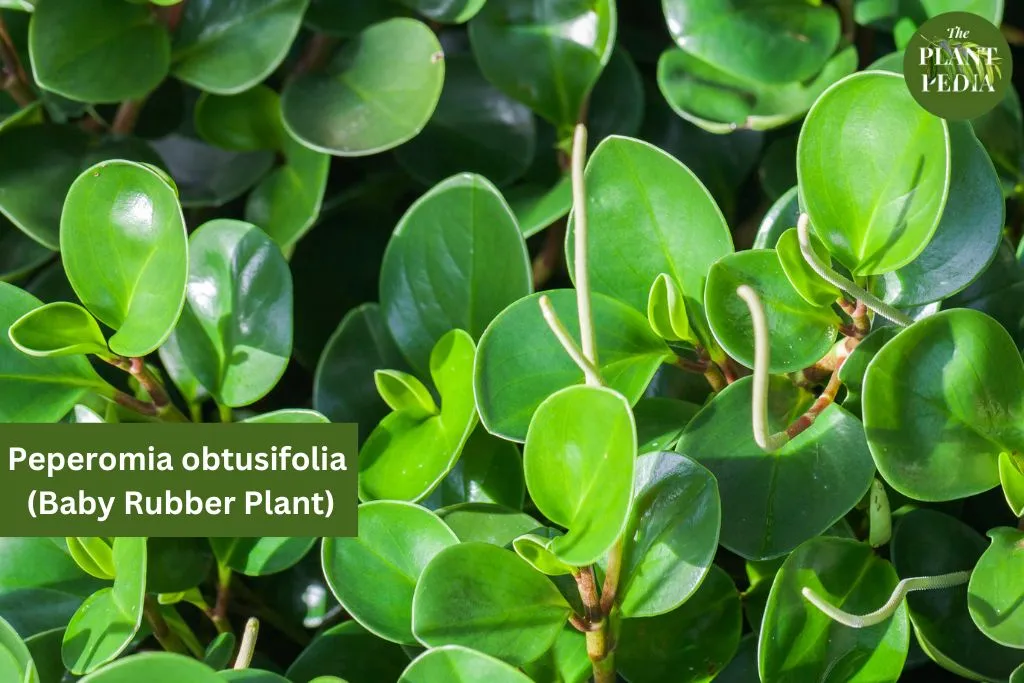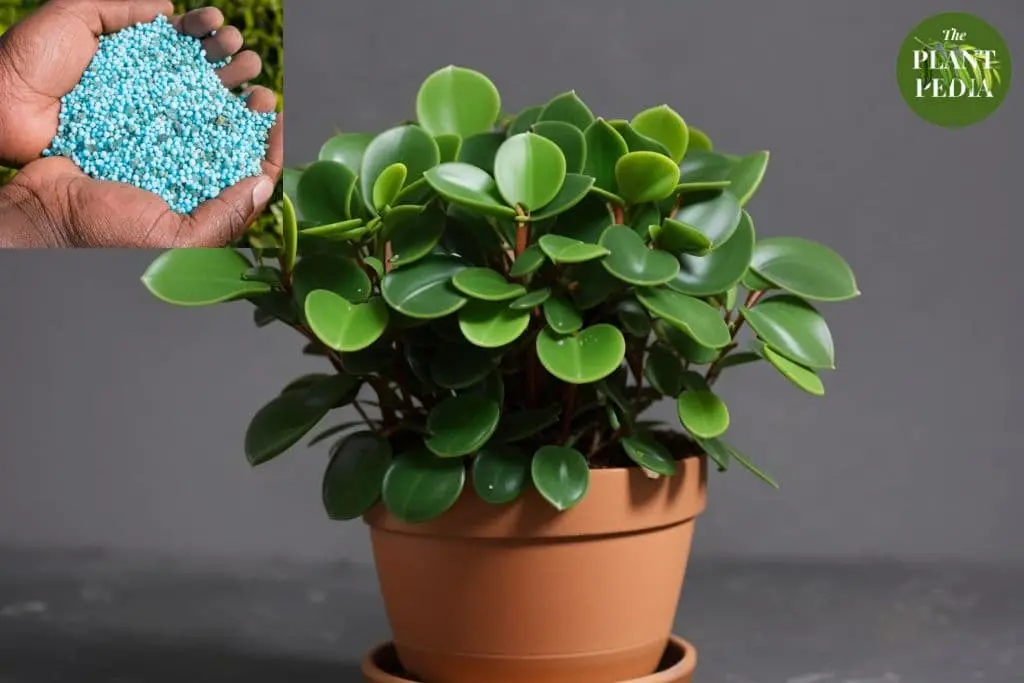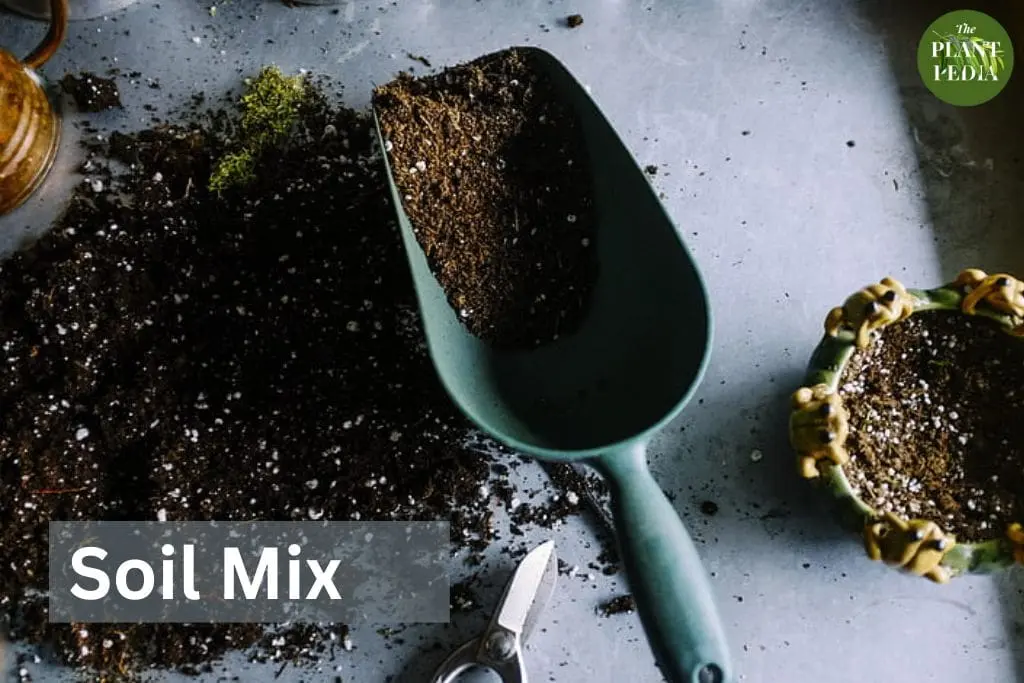Caring for indoor plants is an enriching and rewarding experience, and the baby rubber plant (Peperomia obtusifolia) is no exception.
Known for its thick, glossy leaves and easy maintenance, this popular houseplant can thrive with the right care.
One critical aspect of its care regimen is proper fertilization. In this comprehensive guide, we’ll delve deep into the world of baby rubber plant fertilizer, exploring the types of fertilizers, application techniques, and frequency for optimal growth.
Table of Contents
Baby Rubber Plant Description

Before we dive into the specifics of fertilizing, let’s take a moment to understand the baby rubber plant.
Native to South America, it belongs to the Peperomia genus, which comprises over a thousand species.
The Peperomia obtusifolia, commonly referred to as the baby rubber plant, is cherished for its ornamental leaves and ability to thrive in various indoor environments.
Key Characteristics of the Baby Rubber Plant
- Foliage: The baby rubber plant is distinguished by its thick, succulent-like leaves, which are typically dark green and glossy. They can grow in an upright fashion or cascade, depending on the specific variety.
- Size: These plants are generally small, making them suitable for apartments, offices, and smaller living spaces. They typically reach a height of 6 to 12 inches.
- Light Requirements: While they can tolerate lower light levels, they thrive in bright, indirect sunlight. Direct sun exposure should be avoided, as it can scorch the leaves.
- Watering Needs: Baby rubber plants prefer slightly moist soil but are susceptible to overwatering. Allowing the top inch of soil to dry out before watering is a good practice.

The Role of Fertilizer in Baby Rubber Plant Growth
Fertilizer plays a crucial role in the overall health and vitality of your baby rubber plant. It serves as a supplemental source of nutrients, providing elements that may be deficient in the soil.
These nutrients are essential for various physiological processes, promoting robust growth, vibrant foliage, and overall plant resilience.
Understanding Nutrient Requirements
To ensure your baby rubber plant receives the right nutrients, it’s essential to understand their specific requirements:
- Nitrogen (N): This vital nutrient is responsible for promoting lush, leafy growth and maintaining a vibrant green coloration in the foliage. It’s particularly important for the baby rubber plant’s characteristic glossy leaves.
- Phosphorus (P): Vital for root development, flower production, and energy transfer within the plant, phosphorus is crucial for overall plant vitality.
- Potassium (K): This nutrient supports the plant’s disease resistance, strengthens cell walls, and aids in the regulation of various metabolic processes.
- Micronutrients: These include elements like iron, magnesium, and others, which are required in smaller quantities but are equally essential for enzyme function, chlorophyll production, and other critical processes.
Addressing Potential Soil Deficiencies
Even if you’re using a quality potting mix, over time, the soil’s nutrient content can become depleted. This is especially true in container plants.
Fertilizing provides a necessary supplement to replenish these vital nutrients, ensuring your baby rubber plant has everything it needs for optimal growth.
Balancing Growth and Fertilizer Application
It’s crucial to strike a balance with fertilization. While nutrients are essential, overfertilizing can lead to problems.
Signs of overfertilization include wilting or drooping leaves, leaf burn, stunted growth, and the buildup of excessive soil salts.
Monitoring your plant’s response to fertilization and adjusting your regimen accordingly is key.
Seasonal Considerations
Understanding the seasonal growth patterns of your baby rubber plant is essential for effective fertilization.
During the active growing season (spring and summer), the plant is in a phase of heightened growth and will benefit from regular, balanced feedings.
In contrast, during the winter months, the plant experiences a semi-dormant period. It’s best to withhold fertilization during this time, as the plant’s growth slows down.
Choosing the Right Fertilizer
Selecting the appropriate type of fertilizer is a critical step in ensuring your baby rubber plant gets the nutrients it needs. Options include liquid, granular, water-soluble powder, and organic fertilizers.
Each type has its advantages, so consider factors like convenience, release speed, and the specific nutrient profile when making your choice.
Types of Fertilizers for Baby Rubber Plants
Choosing the right type of fertilizer is a critical step in ensuring the health and vitality of your baby rubber plant.
Each type of fertilizer offers distinct benefits and considerations. Let’s explore the options in more detail:
1. Liquid Fertilizer
Liquid fertilizers are highly soluble, meaning they dissolve easily in water. This makes them readily available for absorption by the plant’s roots.
They are a popular choice for indoor plants due to their convenience and quick nutrient delivery.
- Advantages:
- Fast Absorption: Liquid fertilizers are quickly absorbed by the plant, providing rapid access to essential nutrients.
- Precision in Feeding: It’s easy to control the dosage, allowing you to tailor the feeding regimen to your plant’s specific needs.
- Versatility: They can be applied directly to the soil or as a foliar spray for foliar feeding.
- Application:
- Dilute according to the manufacturer’s instructions. Generally, a half-strength solution is recommended.
- Apply every 4-6 weeks during the active growing season (spring and summer).
2. Granular Fertilizer
Granular fertilizers consist of solid particles that release nutrients slowly over time. They are typically applied to the soil surface, where they gradually break down, providing a sustained source of nourishment.
- Advantages:
- Long-Lasting: Granular fertilizers release nutrients over an extended period, reducing the frequency of applications.
- Low Risk of Overfertilizing: They are less likely to cause nutrient imbalances or overfertilization if applied correctly.
- Application:
- Lightly scratch the surface of the soil to incorporate the granules, being careful not to disturb the plant’s roots.
- Water the plant thoroughly after application to activate the fertilizer.
3. Water-Soluble Powder Fertilizer
Water-soluble powder fertilizers come in a dry, powdered form that is mixed with water before application. They provide a balanced nutrient profile and are versatile in their application.
- Advantages:
- Customizable Formulation: You can adjust the concentration by varying the amount of powder you mix with water.
- Quick Nutrient Uptake: Like liquid fertilizers, they are readily absorbed by the plant.
- Application:
- Follow the manufacturer’s instructions for mixing ratios.
- Apply every 4-6 weeks during the growing season.
4. Organic Fertilizer
Organic fertilizers are derived from natural sources such as compost, animal manure, or plant by-products. They provide a slow-release form of nutrients and contribute to improving the overall soil structure and microbial activity.
- Advantages:
- Soil Enrichment: Organic fertilizers enhance the soil’s fertility and microbial diversity, promoting overall plant health.
- Sustainable and Environmentally-Friendly: They are derived from renewable resources and have minimal environmental impact.
- Application:
- Follow the manufacturer’s recommendations for dosage and frequency.
- Apply during the active growing season.
Choosing the right fertilizer for your baby rubber plant depends on factors like your preferred application method, the specific nutrient needs of your plant, and your personal gardening preferences.
Whichever type you choose, providing a balanced and consistent nutrient supply will contribute to the health and vibrancy of your baby rubber plant.

Fertilizing Techniques for Baby Rubber Plants
Applying fertilizer correctly is crucial to ensure your baby rubber plant receives the nutrients it needs for optimal growth and health.
Here are some key techniques to keep in mind:
1. Dilution and Frequency
For liquid or water-soluble powder fertilizers, it’s important to follow the manufacturer’s instructions for dilution. Using a full-strength solution can lead to overfertilization, which can harm the plant. Instead, aim for a half-strength solution to provide a balanced nutrient supply.
- Frequency: During the active growing season (spring and summer), fertilize your baby rubber plant every 4-6 weeks. This aligns with the period of increased growth and nutrient uptake.
2. Surface Application for Granular Fertilizers
Granular fertilizers are applied to the soil surface, where they gradually release nutrients over time. To apply granular fertilizer:
- Lightly scratch the surface of the soil with a small tool or your fingers. This helps incorporate the granules into the soil without disturbing the plant’s roots.
- Ensure the granules are evenly distributed around the base of the plant.
- Water the plant thoroughly after applying the fertilizer. This helps activate the granules and encourages nutrient absorption.
3. Avoid Fertilizing in Winter
Baby rubber plants experience a semi-dormant period during the winter months. Their growth slows down, and they require fewer nutrients. It’s best to withhold fertilization during this time to avoid overfeeding the plant.
- Monitor your plant closely during this period. If it shows signs of new growth or increased activity, you can resume fertilizing, but do so sparingly.
4. Maintain Balanced Nutrition
While it’s important to provide essential nutrients, it’s equally crucial to avoid overfertilization. Signs of overfertilization include wilting or drooping leaves, leaf burn, stunted growth, and the accumulation of excessive soil salts.
- If you suspect overfertilization, leach the soil thoroughly with water. This involves watering the plant until water runs out of the drainage holes, flushing out excess salts.
- Consider repotting if overfertilization has caused significant damage to the plant.
5. Monitor Plant Response
Pay close attention to how your baby rubber plant responds to fertilization. Healthy plants will show improved growth, vibrant foliage, and a generally robust appearance.
However, if you notice any negative effects like leaf discoloration or wilting, adjust your fertilizing regimen accordingly.
Signs of Overfertilization and How to Remedy
While providing nutrients through fertilization is essential for a healthy baby rubber plant, it’s equally important to be vigilant for signs of overfertilization.
Recognizing these signs early can prevent potential damage and allow for timely intervention. Here are the key indicators of overfertilization and steps to remedy the situation:
Signs of Overfertilization:
- Wilting or Drooping Leaves: Overfertilized plants may exhibit signs of stress, including wilting or drooping leaves. This is a result of the excess salts in the soil affecting the plant’s ability to absorb water.
- Leaf Burn or Browning: The tips or edges of the leaves may turn brown or become scorched. This occurs due to the buildup of salts, which can damage the plant’s root system.
- Stunted Growth: Instead of promoting healthy growth, excessive fertilization can actually hinder a plant’s development. Overfertilized baby rubber plants may display slowed or stunted growth.
- Excessive Soil Salts: If you notice a white crust or residue on the surface of the soil, it’s a clear indication of excess salts, which can be harmful to the plant.
Steps to Remedy Overfertilization:
- Leach the Soil:
- What to Do: Water the plant thoroughly until water starts to drain out of the bottom of the pot. Allow it to sit for a few minutes, then repeat the process. This helps flush out excess salts from the soil.
- Why It Works: Leaching dilutes the concentration of salts in the soil, reducing their harmful effects on the plant’s roots.
- Replace the Soil:
- What to Do: If overfertilization is severe, consider repotting the plant in fresh, well-draining soil. Gently remove the plant from its current pot, shake off excess soil, and replant in a clean container with appropriate potting mix.
- Why It Works: This provides a fresh start with soil that is free from excessive nutrients.
- Adjust Fertilization Practices:
- What to Do: Reduce or suspend fertilization until the plant shows signs of recovery. When you resume, use a diluted fertilizer and apply it less frequently.
- Why It Works: This allows the plant to recover from the effects of overfertilization and prevents further stress.
- Monitor Plant Health:
- What to Do: Keep a close eye on the plant’s progress. Look for signs of new growth, improved leaf coloration, and overall vitality.
- Why It Works: Monitoring the plant’s response helps you gauge whether it’s on the path to recovery or if further adjustments are needed.
Remember, prevention is the best strategy. Always follow recommended dilution rates and frequency guidelines when fertilizing your baby rubber plant.
By being attentive to your plant’s needs and adjusting your care regimen accordingly, you can ensure it thrives in a healthy, balanced environment.
My Additional Tips
Here are some additional tips for fertilizing baby rubber plants:
- Use a balanced fertilizer that is specifically formulated for indoor plants.
- Avoid fertilizers that are high in nitrogen, as this can lead to leaf burn.
- Fertilize during the spring and summer months, when the plant is actively growing.
- Stop fertilizing in the fall and winter, when the plant is dormant.
- Be sure to dilute the fertilizer according to the manufacturer’s instructions.
- Water the plant thoroughly after fertilizing.
Related FAQs:
What Type of Fertilizer is Best for Baby Rubber Plants?
A balanced, water-soluble fertilizer with equal parts of nitrogen, phosphorus, and potassium (10-10-10) is suitable for baby rubber plants. Additionally, organic fertilizers or specialized houseplant fertilizers work well.
How Often Should I Fertilize My Baby Rubber Plant?
During the active growing season (spring and summer), fertilize your baby rubber plant every 4-6 weeks. Reduce or cease fertilization during the winter months when the plant experiences slower growth.
Can I Use All-Purpose Fertilizer for My Baby Rubber Plant?
Yes, you can use an all-purpose, balanced fertilizer for your baby rubber plant. Look for a formulation with equal or close to equal parts of nitrogen, phosphorus, and potassium.
Is it Possible to Overfertilize My Baby Rubber Plant?
Yes, overfertilization can harm your baby rubber plant. Signs of overfertilization include wilting leaves, leaf burn, stunted growth, and excessive soil salts. It’s important to follow recommended dosage instructions and avoid frequent, heavy applications.
What Should I Do if I Suspect Overfertilization?
If you suspect overfertilization, leach the soil thoroughly with water to remove excess salts. Consider repotting if the plant is severely affected. Adjust your fertilizing regimen by using a diluted fertilizer less frequently.
Can I Use Organic Fertilizer for My Baby Rubber Plant?
Yes, organic fertilizers are a great option for baby rubber plants. They provide a slow-release source of nutrients and contribute to overall soil health. Compost, well-rotted manure, and organic plant-based fertilizers are all suitable choices.
Should I Fertilize My Baby Rubber Plant During the Winter Months?
It’s best to withhold fertilization during the winter months when your baby rubber plant experiences a semi-dormant period. The plant’s growth slows down during this time, so it requires fewer nutrients.
What Happens if I Don’t Fertilize My Baby Rubber Plant?
While baby rubber plants can survive without fertilization, they may not thrive as much. Over time, the soil’s nutrient content can become depleted, leading to slower growth and potentially less vibrant foliage. Fertilizing provides essential nutrients for optimal health and vitality.
Can I Use Slow-Release Fertilizer Pellets for My Baby Rubber Plant?
Yes, slow-release fertilizer pellets can be used for baby rubber plants. These pellets release nutrients gradually over time, providing a sustained source of nourishment. Follow the manufacturer’s instructions for application.
What Are Some Signs That My Baby Rubber Plant Needs Fertilizer?
Signs that your baby rubber plant may need fertilizer include slower growth, pale or yellowing leaves, and a generally less vibrant appearance. However, it’s important to ensure that other factors like proper watering and lighting have been addressed before considering fertilization.
Conclusion
Fertilizing your baby rubber plant is a vital aspect of its overall care. By understanding the specific needs of this plant and applying the right type of fertilizer in the correct manner, you’ll promote healthy growth and vibrant foliage.
Remember to monitor your plant’s response to fertilization and make adjustments as needed. With the right care, your baby rubber plant will thrive and bring a touch of natural beauty to your indoor space. Happy gardening!


